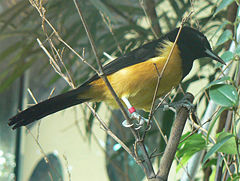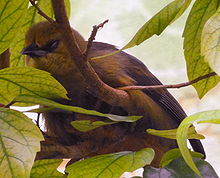- Montserrat Oriole
-
Montserrat Oriole 
Male at London Zoo Conservation status Scientific classification Kingdom: Animalia Phylum: Chordata Class: Aves Order: Passeriformes Family: Icteridae Genus: Icterus Species: I. oberi Binomial name Icterus oberi
Lawrence, 1880The Montserrat Oriole, Icterus oberi, is a medium-sized black-and-yellow icterid (the same family as many blackbirds, meadowlarks, cowbirds, grackles, and others, including the New World orioles).
It inhabits a small area on the island of Montserrat in the Lesser Antilles of the West Indies, and is the national bird of this British territory. It is threatened by habitat loss, and has been classified by BirdLife International as Critically Endangered, with a current estimated population of between 200 and 800. Much of its habitat was destroyed by deforestation, Hurricane Hugo and the volcanic activity between 1995 and 1997.
The oriole once was found in three main areas: the bamboo forest east of Galways Soufrière, the leeward slopes of the Chances Peak mountain and the Centre Hills (especially the Runaway Ghaut area). The diet of the bird consists mainly of insects and fruits. The birds usually lay two spotted eggs. All models indicate that they begin breeding at one year old.Most of them were almost wiped out during volcanoes and only about 200 of them are still surviving.
The binomial of this bird commemorates the American naturalist Frederick Albion Ober.
References
- BirdLife International (2006). Icterus oberi. 2006. IUCN Red List of Threatened Species. IUCN 2006. www.iucnredlist.org. Retrieved on 25 November 2006. Database entry includes justification for why this species is Critically Endangered.
External links

This Icteridae-related article is a stub. You can help Wikipedia by expanding it.


